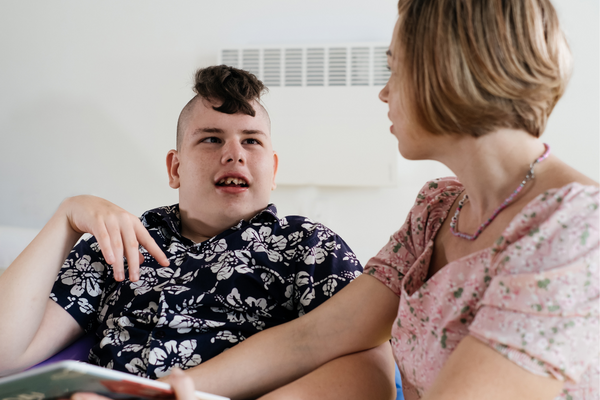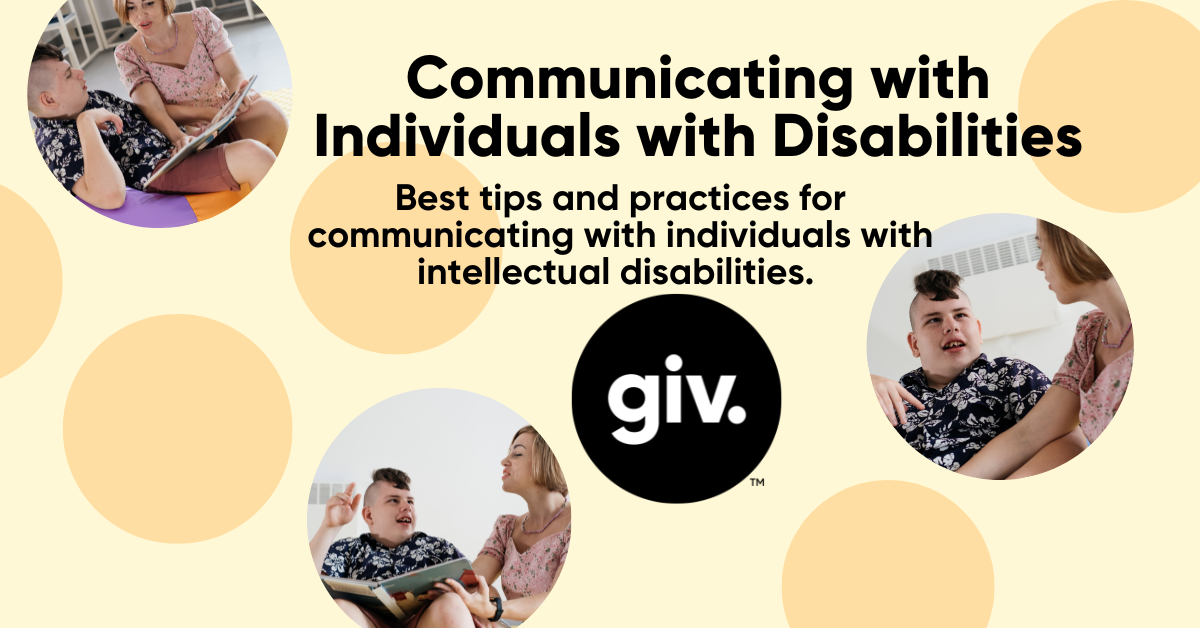Navigating the landscape of caregiving for individuals with disabilities demands a nuanced understanding of effective communication. At its core, communicating with individuals with disabilities is not just a skill but a cornerstone for providing comprehensive and empathetic care.
From acknowledging diverse communication styles to overcoming barriers and fostering inclusivity, the journey to effective communication is pivotal in creating a supportive environment for individuals with intellectual and developmental disabilities.
Communicating with Individuals with Disabilities:
Communication with individuals with disabilities extends far beyond verbal exchanges; it’s about creating a space where every individual, regardless of their abilities, feels seen and heard. In understanding the unique challenges faced by individuals with disabilities, caregivers embark on a journey to establish effective communication channels.
By recognizing the importance of person-first language, caregivers prioritize the individual over their disability, laying the foundation for a relationship built on respect and understanding. The adoption of inclusive language ensures that the communication process is tailored to each person’s preferences, fostering a supportive environment where everyone’s voice is valued.
The communication styles of individuals with disabilities are as diverse as the disabilities themselves. Caregivers need to adapt their approaches, taking into account the specific needs of each person. Whether it’s acknowledging speech disabilities, accommodating different communication methods, or understanding the importance of body language and facial expressions, effective communication becomes a bridge to connect caregivers with those they support.
It is not just about words; it’s about creating an atmosphere that encourages individuals to express themselves in ways comfortable to them, ensuring that their voices are an integral part of their caregiving experience.

Overcoming Communication Barriers:
Communication barriers in disability caregiving often stem from various factors, such as speech disabilities, hearing loss, or cognitive impairments. Gaining proficiency in navigating these challenges is essential for caregivers to provide optimal care. Sign language, communication boards, and augmentative communication devices emerge as invaluable tools in breaking down these barriers.
For caregivers, it’s not merely about adapting to the challenges presented by disabilities but about proactively seeking solutions that empower individuals to communicate effectively.
The stress experienced by caregivers in the disability caregiving field further underscores the need for honed communication skills. Recognizing the signs of caregiver stress and addressing them head-on contribute to a healthier caregiving environment.
Open communication channels among caregiving teams, coupled with the cultivation of a supportive network, become vital components in managing caregiver stress. As caregivers navigate these challenges, they discover that effective communication is not just a tool for connecting with disabled individuals but a means to fortify their resilience and well-being.
Communication Skills for Caregiver Stress:
Caregiver stress is an inherent aspect of the caregiving profession, and effective communication skills play a crucial role in managing this stress. Gaining proficiency in expressing concerns, seeking support, and fostering an environment where caregivers feel heard are pivotal in maintaining the mental and emotional well-being of the caregiving team.
The ability to communicate effectively about stressors and challenges not only enhances the overall caregiving experience but also contributes to a more compassionate and understanding caregiving environment.
Understanding that communication skills are a two-way street, caregivers at times find solace in sharing experiences with one another. The exchange of insights and coping mechanisms becomes a form of support, strengthening the bonds among caregiving professionals.
By prioritizing communication skills as part of caregiver training, organizations can contribute to a culture where stress is acknowledged, discussed, and effectively managed, fostering a resilient and empowered caregiving team.
Person-First Language vs. Identity-First Language:
Language is a powerful tool that shapes perceptions and relationships. In disability caregiving, the choice between person-first language and identity-first language is a crucial consideration. Person-first language emphasizes putting the individual before their disability, reinforcing the idea that their identity is not solely defined by their condition. On the other hand, identity-first language places the disability at the forefront, acknowledging it as an inherent part of the individual’s identity.
Recognizing the preference of each individual is paramount. Caregivers must be attuned to the language choices that individuals themselves use or prefer. This respect for linguistic preferences not only reflects a commitment to individuality but also contributes to creating an inclusive and affirming caregiving environment.
Person-first language and identity-first language are not just linguistic choices; they represent a deeper commitment to acknowledging and respecting the diverse identities and experiences within the disabled community.

Sign Language and Sign Language Interpreters:
For individuals with hearing impairments, sign language is a cornerstone of effective communication. Caregivers must be adept in basic sign language or collaborate with sign language interpreters to facilitate seamless communication. The presence of sign language interpreters becomes crucial in various settings, ensuring that individuals with hearing disabilities have access to information and can actively engage in conversations.
Sign language is not just a mode of communication; it is a bridge that connects individuals with the world around them. Caregivers who invest time in learning sign language or work alongside interpreters demonstrate a commitment to fostering inclusivity.
By embracing sign language as a tool for communication, caregivers contribute to breaking down barriers and creating an environment where individuals with hearing impairments can express themselves freely and participate fully in their caregiving experience.
Recognizing Different Communication Styles:
The diversity within the disabled community extends to unique communication styles, each shaped by an individual’s experiences and abilities. Caregivers must adapt their communication approaches to accommodate these varied styles, recognizing that there is no one-size-fits-all method. Understanding body language, interpreting facial expressions, and navigating abstract language become integral aspects of effective communication.
Adapting to different communication styles is not just a skill; it is an expression of respect for individuality. Caregivers who invest time in understanding the nuances of non-verbal communication demonstrate a commitment to providing person-centered care.
By acknowledging and embracing diverse communication styles, caregivers foster an environment where individuals feel understood and valued, enhancing the overall quality of the caregiving relationship.
Visual Aids and Large Print:
Individuals with low vision or visual impairments often face challenges in accessing information. In response, caregivers must incorporate visual aids and large print materials into their communication strategies.
This commitment to accessibility ensures that individuals with visual impairments can actively engage in the communication process, empowering them to make informed decisions and participate fully in their care.
Caregivers should proactively provide information in formats that are accessible, considering the diverse needs of those they support. Whether it’s utilizing large print materials, incorporating tactile elements, or leveraging technology for audio descriptions, the goal is to create an environment where visual impairments do not limit access to essential information.
By embracing these strategies, caregivers contribute to a more inclusive caregiving experience, where every individual, regardless of their visual abilities, can navigate their world with confidence.

Avoiding Jargon and Using Inclusive Language:
Effective communication in disability caregiving involves avoiding jargon and adopting inclusive language. Caregivers should be mindful of the potential barriers that technical or specialized language can create.
By using language that is easily understood by individuals with varying levels of abilities, caregivers foster a communication environment that is inclusive and respectful.
Inclusivity in language is not just about the words used; it’s about creating an atmosphere where everyone feels comfortable expressing themselves. Caregivers who prioritize person-first language and steer clear of unnecessary technical terms contribute to a communication environment where individuals with disabilities are empowered to actively engage.
The choice of language becomes a conduit for breaking down barriers and fostering a sense of belonging within the caregiving relationship.
Maintaining Eye Contact and Moderate Pace:
Non-verbal cues, such as maintaining eye contact, play a pivotal role in effective communication. Caregivers must recognize the significance of this non-verbal aspect, as it communicates attentiveness, respect, and a genuine connection.
Ensuring that individuals with cognitive or processing difficulties can follow the conversation requires caregivers to communicate at a moderate pace, allowing for comprehension and engagement.
Maintaining eye contact is not just a communication skill; it is an expression of presence and acknowledgment. Caregivers who prioritize this non-verbal cue contribute to a caregiving environment where individuals feel seen and valued.
Similarly, adopting a moderate pace in communication is an essential aspect of creating an inclusive space, ensuring that information is conveyed effectively to individuals with varying cognitive abilities.
Fostering Inclusivity in Healthcare Settings:
The commitment to fostering inclusivity extends beyond individual caregiving interactions to healthcare settings. Health care providers play a pivotal role in recognizing and addressing diverse communication needs.
Accommodations, such as sign language interpreters, accessible materials, and a commitment to person-first language, become essential components of providing inclusive healthcare.
In healthcare settings, caregivers must be attuned to the unique challenges faced by individuals with disabilities, ranging from sensory sensitivities to communication barriers. By fostering an inclusive healthcare environment, health care providers contribute to a broader commitment to equitable and accessible care.
Recognizing the importance of diverse communication needs ensures that individuals with disabilities can navigate healthcare settings with confidence, actively participate in discussions about their health, and receive the care they deserve.
Conclusion:
In conclusion, effective communication with individuals with disabilities is a journey that requires continual learning, adaptation, and a commitment to inclusivity. From acknowledging diverse communication styles to overcoming barriers and prioritizing person-first language, caregivers play a pivotal role in creating an environment where every individual feels valued and understood.






